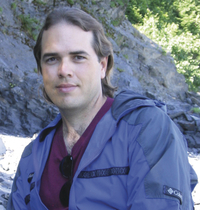The Better Part of the Journey
Readers, please enjoy this guest blog post by Cliff Seruntine, author of Seasons of the Sacred Earth.
Some say enchantment is only a fancy, a carry over from times long past when our ancestors knew no better. Others say enchantment is a tool and can be shaped to serve their own ends. But there are those who say it is something else altogether—the very essence of life and wonder; a vital link to mystery and wisdom. Come to know it and it will enrich how one approaches life, from the chores of day-to-day to how we interact with the numinous. 
The shamans of aboriginal folk, the wise men and women of old Europe, and even the common folk of the distant past (before urbanization drew people far from the land) knew how to find enchantment. It was all around them, in their crops as they pushed up from the earth and in the green shadowed depths of the forest. The ancestors lived very close to the natural world—they drew their lives directly from it. How could they not know enchantment? It derives of Nature.
And while enchantment is no mere tool, it is a wellspring of power and hidden knowledge when used to good purpose. In Alaska, an aboriginal boy once told me of how his grandfather—the village shaman—used it to shape-shift into a bird to seek out the caribou upon which the people of his village depended. Witches of old drew upon enchantment to heal sick persons and livestock with secret charms. I have called upon it and seen an ailing garden revive beyond belief, and found myself suddenly with the knowledge of what to do to help that healing along.
The magical folk of old valued enchantment so deeply they told faery tales of it, created traditions to show respect of it, and founded many practices designed to draw them close to enchantment. They go by different names in different paths, but in essence these are vision quests and spirit quests. They involved entering the Otherworld with a foundation of ancestral knowledge, facing profound ordeal, and emerging with new insight and power. Yet while the quests are the subject of many current books and seminars, the other essential part of drawing close to enchantment is oft overlooked in the modern, urbanized era: the necessity of a relationship with the green world. Michael Harner, in his groundbreaking book The Way of the Shaman (Harper Collins, ©1980), wrote that the shamanic state of consciousness “[i]nvolves a deep respect for all forms of life, with a humble awareness of our dependence on the plants, animals and even inorganic matter of our planet.” In essence, knowing enchantment is closely tied to an understanding of the natural world.
Enchantment is out there, and finding it is not so hard. The shaman’s first vision quest, the witch’s initiation, the mystic’s first tentative meditations—they set one pointedly down the path. But that is only part of the journey; the other part comes of drawing close to the natural world. Tend a garden. Learn the ways of wild flora and creatures. Listen to the secrets trees whisper when the wind blows. In short, fall in love with the sacred Earth. The magical paths may teach you how to work with enchantment, but it is the green world that teaches you the better part—how to relate to enchantment, and more importantly, why.
Our thanks to Cliff for his guest post! For more from Cliff Seruntine, read his article “A Perfect Rain on an Enchanted Homestead.”








[…] The Better Part of the Journey (llewellyn.com) […]